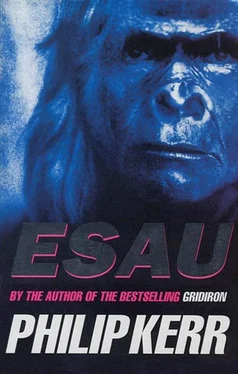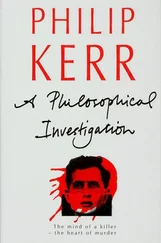‘If we were able to put aside the knowledge of our simian status and, at the same time, we were able to rent Michael J. Fox’s Delorean-shaped time machine and travel back in time some five or six million years, to the middle Pliocene epoch, we would discover that monkeys were the planet’s dominant primate. After all, there were so many of them. We might even think that they were the better bet as far as inheriting the earth was concerned, and that their larger, slower, knuckle-walking, brachiating cousins represented a bit of an evolutionary dead-end.
‘But then, if we could return to our time-travelling Delorean and go forward by another few hundred thousand years — just how far we would have to go is also a matter of considerable disagreement among paleoanthropologists — we should notice how one particular bipedal ape seemed to be showing considerable evolutionary promise and might be worthy of careful monitoring.
‘The question why this one small branch of a numerically unsuccessful species should suddenly develop in such a spectacular way is something that continues to puzzle scientists, and surely, there is no subject of greater interest to us. But the question assumes even greater pertinence the more one comes to appreciate just how much of an ape we really are. Not just Todd. But all of us.
‘Some of you will perhaps recall that in 1540, Copernicus published the results of his astronomical observations that overthrew forever the traditional Ptolemaic view of the universe, in which the sun and the stars revolved around planet Earth. With good reason, you might think it strange that it was another four hundred years before paleoanthropology was similarly able to overthrow the prevailing orthodoxy that saw man as the inevitable and ultimate product of evolution on Earth. We now know that it is wrong to see evolution as a constant progression, like some inexorable assembly line that results in the Ultimate Being — man himself. Nature is not so clear-cut. And the sooner you are all able to empty your minds of this myth of evolutionary progress that sees the ape as an inferior being left behind by a pushy cousin striving toward its own Nietzschean destiny, the sooner you can call yourselves proper paleoanthropologists. To this end, I want to spend the rest of our time considering our ape status.
‘Back in 1962, Tarzan was being played not by Johnny Weissmuller but by Jock Mahoney. I’m not sure who took the part of Cheetah, his faithful chimpanzee friend, but suffice it to say that there was not a lot to choose between them when it came to acting. Either way, one was still able to suspend belief and accept the continued validity of the Edgar Rice Burroughs story line, that man and ape were so close that a man might be brought up among apes and indeed, upon growing to manhood, come to dominate them.
‘Now around the same time, a scientist named Morris Goodman picked up on something that people had more or less forgotten: the discovery by George Nuttall, a professor of biology at the University of Cambridge, that the chemistry of blood proteins might be used to determine the genetic relatedness between higher primates. Using Nuttall’s approach on blood-serum proteins, Goodman discovered that the antigens of man and chimp are practically identical. At the time, everyone — with the possible exceptions of Tarzan and Cheetah — believed that a chimp had more in common with a gorilla than with a man. But Goodman proved that this was simply not the case.
‘Since then, using techniques vastly superior to those of Goodman, molecular anthropologists — most notably Vince Sarich and Allan Wilson of this university — have been able to attach numerical values to Goodman’s astounding discovery.’
Swift sipped a glass of water and then explained how, using albumin, one of the proteins commonly found in blood, it was possible to measure differences of as little as one amino acid in a hundred and, in effect, how it was possible to establish a precise difference in terms of DNA between one species and another.
‘The numbers are quite impressive,’ she said. ‘And in a way, they’re also quite shocking. Whereas the DNA between two species of frog can differ by as much as eight percent, the DNA difference between a man and a chimp is only one-point-six percent. One-point-six percent! ’
She wrote the number on the blackboard and then paused in order to allow the statistic to sink into her students’ minds. She shook her head as if she was still impressed by it herself. She was.
‘You know, that is less than the DNA difference between two species of gibbon, between a horse and a zebra, between a dog and a fox and, most important of all, between a chimpanzee and a gorilla. In other words we have more in common with a chimp than he does with a gorilla.
‘One-point-six percent is not much of a difference to account for Aristotle, Shakespeare, Michelangelo, Mozart, Wagner, Picasso, and Einstein. But what they achieved is perhaps even more remarkable when you look at it the other way. Maybe you remember Sir Arthur Stanley Eddington’s suggestion that if an infinite number of monkeys were strumming on typewriters, they might write all the books in the British Museum. But the fact is that every one of those books in the British Museum was written by a man who shares ninety-eight-point-four percent of his genetic makeup with a chimpanzee.
‘Jared Diamond, who is a professor of physiology at this university, has argued the case for man as the third chimpanzee. Founding his thesis on a school of taxonomy called cladistics, which says that the classification of living things should be objective and uniform and based on genetic distance or lines of divergence. Diamond argues that chimps, gorillas, and man all belong within the same genus. And he says, because our genus name Homo came first, that this should take zoological priority. This has the anthropocentric result that we must now think of not one but four species of the genus Homo on earth today: the common chimpanzee, the pygmy chimpanzee, man himself, and — slightly more distinct — the gorilla.
‘Now that’s not a bad idea at all, especially when you consider how the first specimens of ape got their names. It’s said that the word chimpanzee was taken from a Portuguese-Angolan word meaning ‘mock man’. Orangutan is Malay for ‘man of the woods’. Also, while the word gorilla is Greek, it may in turn also derive from another African word meaning ‘wild man’. Maybe it’s only these Latin handles that have made us forget who and what these creatures are. Think about it.
‘Four different kinds of man, when previously we thought there was only one. So much for the question, asked by astronomers and cosmologists everywhere: Are we alone? Clearly the answer must be, no — we’re not alone. We never have been.
‘It’s possible that some of you will be aware of how, in an effort to protect the dwindling populations of gorillas and chimpanzees from poachers, a number of African countries have taken Professor Diamond’s arguments on board, and are changing their laws on homicide so as to include these new species of the genus Homo . In these countries, killing a gorilla will soon be classed as murder and the perpetrator punished with the full severity of the law. Highly commendable, yes. But it’s worth bearing in mind that Homo sapiens is not the only species of Homo that engages in mass murder of its own kind. Jane Goodall has described how, over a period of years, she observed one group of chimpanzees being systematically exterminated by another. Goodall ascribed the fact that the extermination took so long due only to the lack of efficient killing tools of the kind that Homo sapiens excels in manufacturing. Dian Fossey’s work with gorillas goes a long way to support the suggestion that the average ape — especially infant apes — stands as good a chance of being murdered by another of its kind as the average American.
Читать дальше












